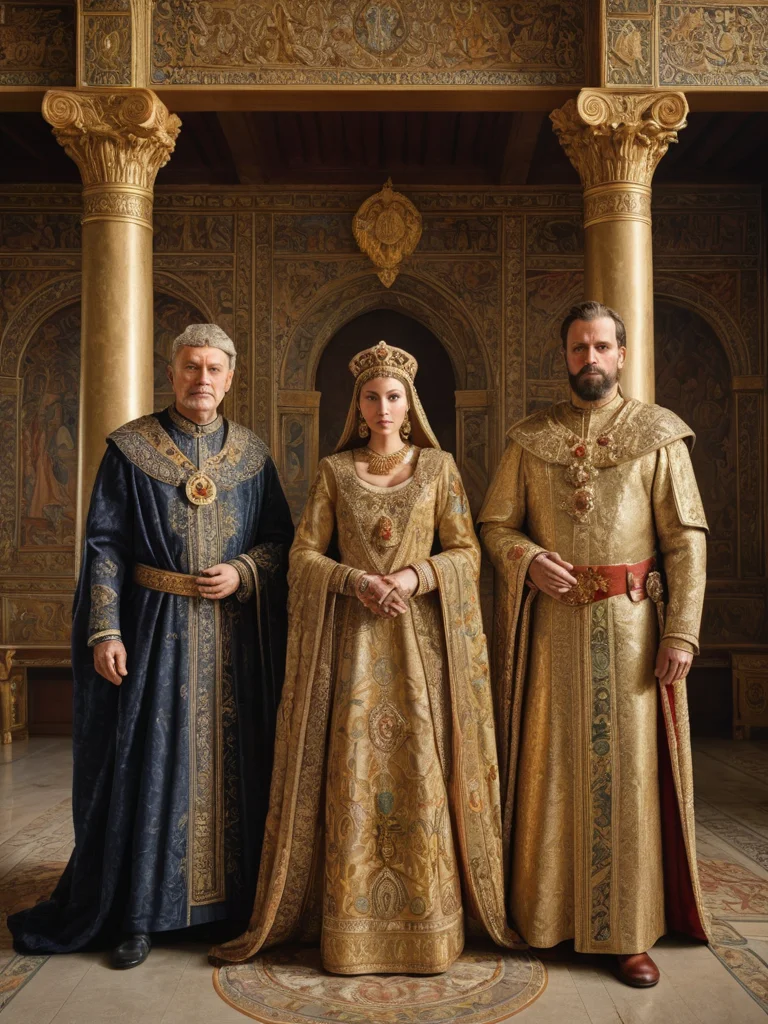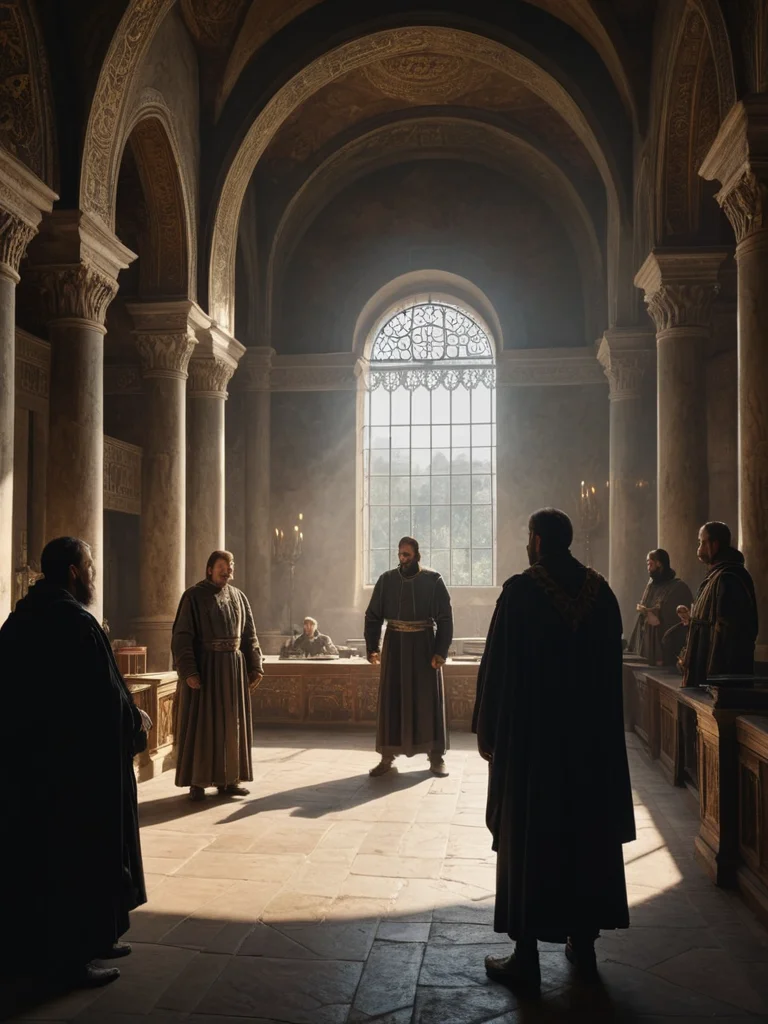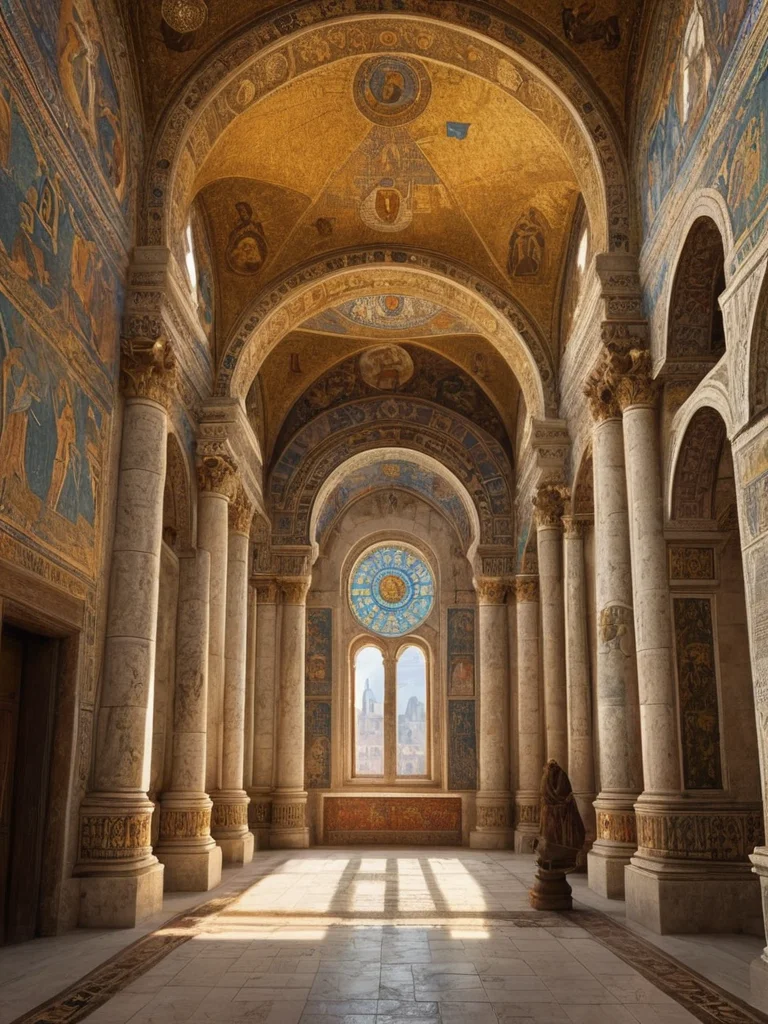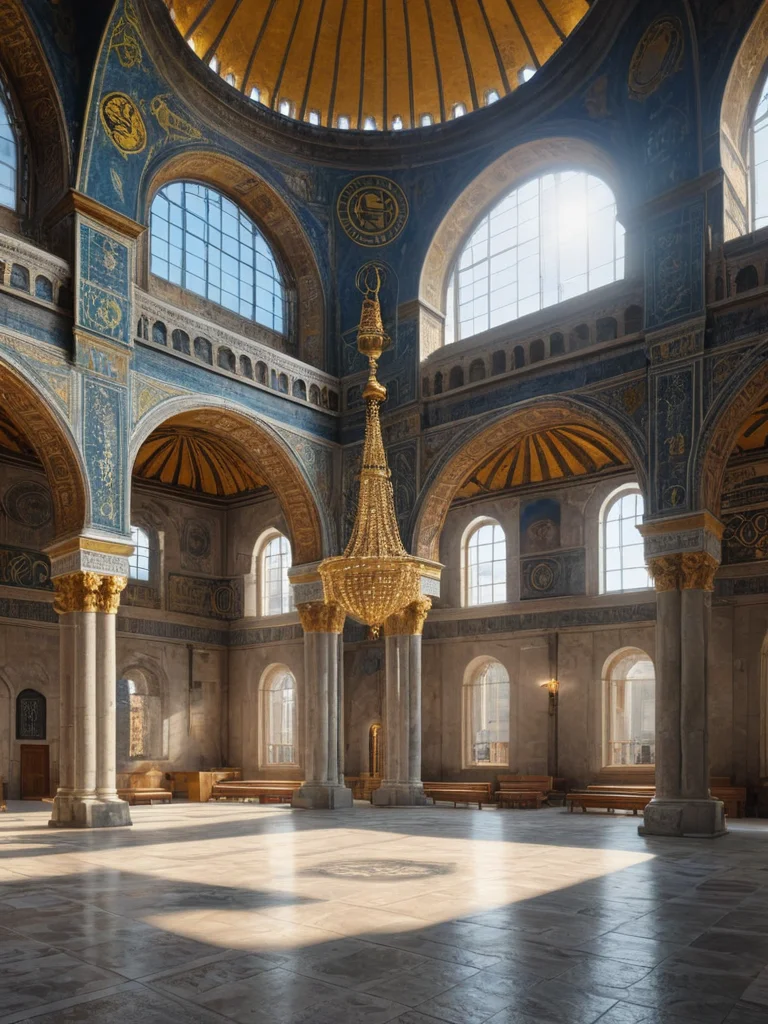Before delving into the world of gold, intrigue, and ceremonies, it is essential to understand why Constantinople, the capital of the Byzantine Empire, occupied such a unique position on the map of the medieval world. Historians agree: it was not just a city, but a living embodiment of imperial power, a cultural and religious beacon, and its court was the heart through which wealth, power, and information flowed from all corners of the known world. This was partly due to its strategic location at the crossroads of Europe and Asia, making it an indispensable center for trade and diplomacy. Constantinople, or New Rome, as it was often called, was a bridge between East and West, a place where cultures, ideas, and ambitions mingled.
In the eyes of contemporaries, especially those living in the West after the fall of the Roman Empire, Byzantium was a bastion of civilization, the heir to Roman traditions, and the guardian of ancient knowledge. The Byzantine Emperor, the Basileus, was considered not just a ruler, but a divinely chosen one, Christ’s representative on Earth. His power was absolute, sanctified by the church and supported by a complex bureaucratic machine. This is where the almost mystical reverence surrounding the emperor’s person originated. His court was not merely the residence of the ruler and his family; it was a meticulously organized organism where every gesture, every outfit, every ceremony held deep symbolic meaning. It was the center of administration for a vast empire, stretching from the Balkans to the Middle East and North Africa at its peak.
For visiting ambassadors and merchants, the court of Constantinople was not just a residence but a portal to another world, a world of unimaginable luxury and strict etiquette. Here, the fates of states were decided, alliances were forged, wars were waged, and arts flourished. Every audience with the emperor was a spectacle designed to leave an indelible impression on anyone who dared to approach this center of power. The secrets of Byzantine diplomacy, their skill in manipulation and negotiation, became legendary. The court was both a school and an arena for intrigue, where ambition and greed intertwined with loyalty and devotion. This is precisely why understanding Constantinople’s role as the center of the world is key to unlocking all subsequent aspects of its court’s daily life and morals.
Splendor and Gold: The Incredible Luxury and Lavish Ceremonies of the Byzantine Court

The Byzantine court, located in the Great Palace of Constantinople, was a true embodiment of luxury, designed to dazzle and amaze. It was not merely a display of wealth but a carefully thought-out strategy to strengthen the emperor’s power and assert his divine status. Upon entering the imperial halls, foreign ambassadors and even subjects of the empire found themselves in a world where gold, precious stones, and the finest fabrics were ubiquitous. Sources describe the palace walls adorned with mosaics of golden tesserae, floors paved with marble, and ceilings shining with gilding. The air was filled with the scent of incense, and music flowed from unseen sources, creating an atmosphere of almost heavenly bliss.
The heart of this luxury was the throne room, known as the Chrysotriclinium, or the Golden Hall. Here, the emperor sat on Solomon’s throne, which, according to accounts, was not just a chair but a marvel of engineering. It was equipped with lifting mechanisms capable of raising the Basileus high above the heads of visitors, emphasizing his elevated position. Golden lions stood on either side of the throne, which, according to descriptions, roared and wagged their tails, while gilded birds on the branches of a golden tree sang with mechanical voices. These moving and sounding statues, powered by complex hydraulic and pneumatic systems, were created to astound the imagination and inspire awe of the power of Byzantine engineers and, of course, of the emperor, whose presence was like a miracle.
Special attention was paid to imperial ceremonies, which were incredibly lavish and strictly regulated. Every action, every step, every bow was part of a complex ritual designed to emphasize the hierarchy and grandeur of imperial power. From receiving ambassadors to solemn processions to church, from festive banquets to sporting events at the Hippodrome – everything was filled with symbolism. The emperor and empress wore luxurious robes embroidered with gold, pearls, and precious stones, and their crowns were studded with priceless gems. The attire did not merely display wealth; it served as a “calling card” of status, with every detail having significance. For example, the color purple was exclusively imperial, and its use was strictly controlled.
Banquets at court were no less impressive. Tables overflowed with exquisite dishes prepared from rare ingredients brought from all corners of the empire and beyond. Wines, delicacies, and sweets were served. Musicians played unusual instruments, and dancers and acrobats entertained guests. All this created an atmosphere of an otherworldly feast, where time seemed to stand still, and one could feel part of something great and eternal. These ceremonies and luxury were not just a display of vanity; they were a vital tool of foreign policy, a way to impress neighboring peoples and compel them to recognize the greatness of Byzantium. Internally, they served to maintain order and legitimize imperial power, reminding subjects of their ruler’s divine election.
A Day in the Life of the Basileus: What Was Hidden Behind the Screen of Ceremonies and Gilding?

Behind all this brilliant splendor and strict etiquette, however, lay the tense and often monotonous life of the Byzantine emperor. The Basileus’s day was scheduled to the minute, a never-ending series of rituals, official receptions, and state affairs. It was a life in a golden cage, where every aspect was meticulously controlled, and solitude was a rare luxury. Historians, studying Byzantine sources, reconstruct a picture where the emperor’s personal space and time were minimal.
A typical day for the Basileus began early in the morning with prayer. The emperor was not only a secular ruler but also a defender of Orthodoxy, so religious rites occupied a significant place in his schedule. He often attended the palace chapel or even Hagia Sophia for morning service. After this, a series of official events would begin. These could include audiences with ministers, generals, dignitaries, and foreign ambassadors. Each audience followed a strict protocol, with all the rituals of bowing and expressing reverence for the imperial person observed. The emperor received reports, issued decrees, and resolved issues of jurisprudence and economics.
Throughout the day, the Basileus also handled administrative matters, reviewing reports from the provinces and orders for the army and navy. Much of his time was spent making decisions that could affect the lives of millions. Despite having an extensive bureaucratic apparatus, the final word always rested with the emperor. Lunches and dinners were also part of the official schedule, often turning into receptions for close associates or ambassadors. Even during meals, the emperor could rarely relax; it was another opportunity to demonstrate grandeur and power.
Evenings might be dedicated to reading, studying theological or philosophical texts, and short moments with family, although even these moments often occurred under the watchful eyes of courtiers. The imperial family was also part of the state machinery: marriages were contracted for political reasons, and children were raised for future service to the empire. The life of the Basileus was full of restrictions and devoid of many simple joys. He was constantly under threat of conspiracy, illness, or popular discontent. It is no coincidence that many emperors sought refuge in monasteries after abdicating the throne or dreamed of it as the only way to find peace. Behind the outward gilding and ceremonies lay the colossal responsibility and loneliness of supreme power.
Secrets and Conspiracies: Who Wove Intrigues in the Treacherous World of the Byzantine Court?

The world of the Byzantine court was not only a world of gold and splendor but also an arena of constant intrigue, conspiracy, and power struggles. Historians note that the turnover of emperors in Byzantium was remarkably high, and the methods of this turnover were often quite dramatic. Poisonings, blinding, depositions, exiles to monasteries – all were part of the daily reality for those in close proximity to the throne. The term “Byzantine intrigue” is not accidental; it has become a byword, signifying a complex, cunning, and multi-layered scheme to achieve personal or group goals.
The main players in this under-the-table struggle were various groups of influence. Firstly, there were, of course, the members of the imperial family: brothers, sisters, uncles, nephews who could claim the throne or wished to expand their influence. The history of Byzantium is replete with examples of internecine strife within the ruling dynasty. Secondly, court eunuchs played a huge role. They often held key administrative posts, controlled access to the emperor, managed the palace economy and finances. Since eunuchs could not claim the throne or establish their own dynasties, they often became loyal servants of the emperor, yet they possessed colossal power, which they could use for their own benefit by manipulating the Basileus or his entourage.
Thirdly, military leaders and the army held significant influence. Many Byzantine emperors were placed on the throne by military coups. The support of the guard or provincial armies was critically important for retaining power. Changes of emperors were often accompanied by bloody repressions against the supporters of the previous ruler. The Church and the Patriarch were also a powerful force. Although they could not directly claim the throne, their approval or disapproval could significantly affect the legitimacy of the emperor and public sentiment. Conflicts between secular and spiritual power were not uncommon and could also lead to political crises.
The methods of intrigue were diverse: from spreading rumors and compromising material to direct murder. A particularly cruel but common way to eliminate rivals was blinding (depriving someone of sight made them incapable of ruling, as the emperor had to be “seeing,” i.e., perfect) or physical mutilation (e.g., cutting off the nose or tongue). Another popular method was forced tonsure as a monk, which also deprived a person of the right to the throne. Conspiracies were often hatched in secret, with extreme confidentiality, using spies and informants, which made the court a place of constant tension and paranoia. This world of intrigue, though seemingly cruel, was an integral part of the empire’s political life, where power was absolute, and the struggle for it was ruthless.
The Legacy of the Golden Court: How Did Byzantium Influence World History and Our Perceptions of Luxury?

Although the Byzantine Empire ceased to exist in 1453 with the fall of Constantinople to the Ottoman Turks, its legacy, and especially the legacy of its golden court, had a profound and multifaceted influence on world history. This influence extended far beyond political borders and shaped our perceptions of state administration, art, religion, and even the very concept of luxury and ceremony.
One of the key aspects of the Byzantine legacy is its legal system. Byzantium was the guardian of Roman law, which was codified in the famous Code of Justinian. This legal compilation formed the basis of jurisprudence in many European countries and continues to influence modern legislation to this day. The strict bureaucratic apparatus developed in Constantinople to manage the vast empire also became a model for subsequent states, including Kievan Rus’, which largely adopted Byzantine principles of state organization.
Byzantine diplomacy was legendary. The empire repeatedly demonstrated mastery in conducting negotiations, using cultural influence and wealth to achieve its goals, avoiding costly wars. Ambassadors who visited Constantinople returned home, amazed not only by the splendor of the court but also by the cunning and sophistication of Byzantine diplomats. This experience influenced the formation of diplomatic practices in Western Europe and the East.
However, the most noticeable and tangible influence of Byzantium is on art and architecture. Golden mosaics, icon painting, complex fresco art, and domed cathedrals – all became hallmarks of the Byzantine style. These artistic traditions spread throughout the Orthodox world, from Rus’ to the Balkans, and even influenced the art of Western Europe during periods of interaction with Byzantium. The grandeur of Hagia Sophia in Constantinople inspired architects for many centuries.
Finally, the concept of luxury and ceremony developed at the Byzantine court became a standard for many monarchical courts around the world. Echoes of Byzantine splendor can be seen in European royal courts, in the ceremonies of the Tsardom of Russia and the Russian Empire, and even in the court traditions of the Ottoman Empire, which, ironically, inherited Constantinople. The symbolism of imperial power, the richness of vestments, the complexity of rituals – all were borrowed and adapted. Byzantium, thus, left behind not only ruins and manuscripts but also a deep cultural imprint, reminding us how one empire managed to combine ancient heritage with Eastern luxury and Christian spirituality, creating a unique and inimitable world of the golden court.
